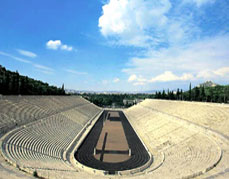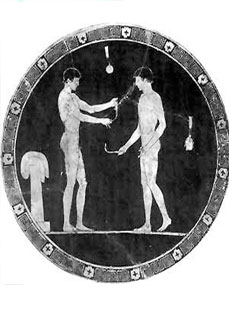

Panathenaic way and other athletic infrastructure in ancient Athens
The most obvious topographical feature relating to this festival is the broad street of the Panathenaea, the Panathenaic Way, which runs for approximately a kilometer from the northwestern gates of the city near the Kerameikos, through the Agora, and up to the Acropolis. The Great Procession (pompe) in honor of Athena, with its 100 sacrificial cattle, formed at a special building called the Pompeion and marched from there to the altar of Athena. Along part of this same route there also took place one of the more spectacular equestrian events, the race of the apobates(=dismounters), in which warriors leapt off of and ran beside racing chariots and then leapt back on.
Before Perikles built the Odeon, the musical contests as well as other events took place in the middle of the city's public square, the Agora. This area was often referred to as the "orchestra," and large portholes are evidence of the supports for wooden bleachers known as irked. Near one group of portholes are five square limestone blocks, each with a central socket, spaced at regular intervals; these once helped anchor the starting gates of a racetrack that accommodated ten runners. It has been suggested that the layout of the city center was determined in part by its function as a site for the Panathenaic games.
Later the gymnastic events were moved to the Panathenaic stadium nestled in a convenient valley across the Ilissos River southeast of the Acropolis. The modern reconstruction of this stadium, originally built late in the 4th century B.C., dates from the first Olympics of modern times, which were held there in 1896. Most of the equestrian events probably took place in a hippodrome located on a broad open plain near the coast at Phaleron, where today there is a modern racetrack.
In addition to these formal facilities, Athens, like other large Greek cities, had some half-dozen exercise grounds or gymnasia (plural for "gymnasium"), literally places where men stripped for exercise. Here boys and young men could run, box, wrestle, jump, and throw the discus. On Athenian vase paintings this setting is often indicated by a short pillar that acted as a turning post for races.
